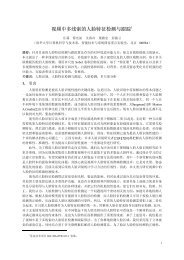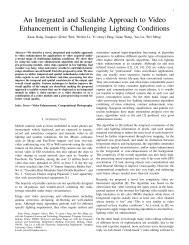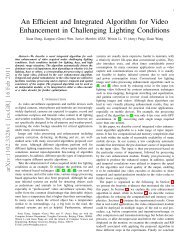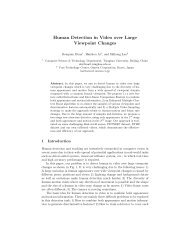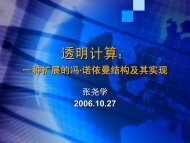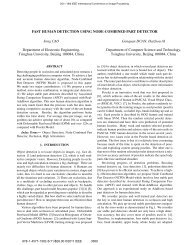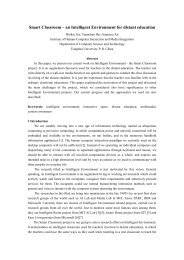Binary Stereo Matching
Binary Stereo Matching
Binary Stereo Matching
Create successful ePaper yourself
Turn your PDF publications into a flip-book with our unique Google optimized e-Paper software.
21st International Conference on Pattern Recognition (ICPR 2012)<br />
November 11-15, 2012. Tsukuba, Japan<br />
<strong>Binary</strong> <strong>Stereo</strong> <strong>Matching</strong><br />
Kang Zhang, Jiyang Li, Yijing Li, Weidong Hu, Lifeng Sun, Shiqiang Yang<br />
Department of Computer Science, Tsinghua University, Beijing, China<br />
Abstract<br />
In this paper, we propose a novel binary-based<br />
cost computation and aggregation approach for stereo<br />
matching problem. The cost volume is constructed<br />
through bitwise operations on a series of binary<br />
strings. Then this approach is combined with traditional<br />
winner-take-all strategy, resulting in a new local<br />
stereo matching algorithm called binary stereo matching<br />
(BSM). Since core algorithm of BSM is based on binary<br />
and integer computations, it has a higher computational<br />
efficiency than previous methods. Experimental<br />
results on Middlebury benchmark show that BSM<br />
has comparable performance with state-of-the-art local<br />
stereo methods in terms of both quality and speed.<br />
Furthermore, experiments on images with radiometric<br />
differences demonstrate that BSM is more robust than<br />
previous methods under these changes, which is common<br />
under real illumination.<br />
1. Introduction<br />
<strong>Stereo</strong> matching, which is to estimate depth or disparity<br />
map from two rectified images (left/right view),<br />
is a traditional problem in computer vision. It has wide<br />
applications in many areas including image-based rendering,<br />
robot navigation, etc. State-of-the-art stereo<br />
matching algorithms can generate reasonably good<br />
depth maps for images under ideally-configured illumination<br />
[10]. However, real stereo images usually<br />
have radiometric differences between left and right<br />
views, making stereo matching much more difficult [6].<br />
Scharstein et al. gave a detail taxonomy and evaluation<br />
of stereo matching algorithms in [11] and according to<br />
[11], most stereo methods mainly consist of four steps:<br />
cost computation, cost aggregation, depth optimization<br />
and depth refinement (Figure 1). Based on different<br />
strategies adopted in depth optimization, stereo methods<br />
can be mainly classified into two categories: local<br />
methods and global methods.<br />
In stereo matching, cost computation and aggregation<br />
is to construct a matching cost volume C(x, d),<br />
where x represents an image pixel from one view, d<br />
represents one of all possible disparity values for x and<br />
(a) (b) (c) (d)<br />
Figure 1. Depth results of BSM after different<br />
stages. (a) is the left view of input image<br />
pair (Cones dataset [10]); (b)–(d) are<br />
depth results after cost computation, cost<br />
aggregation and depth refinement<br />
C(x, d) is the matching cost when assigning disparity d<br />
to pixel x. Cost volume largely determines the performance<br />
of stereo algorithms in both local methods and<br />
global methods. In local methods, final disparity assignment<br />
for pixel x is calculated using winner-take-all<br />
(WTA) scheme:<br />
d x = arg min C(x, d) (1)<br />
d∈D d<br />
where d x is the disparity for pixel x and D d represents<br />
possible disparity ranges (in most of the cases,<br />
D d = [0, d max −1]). In global methods, the data term is<br />
constructed based on the cost volume. Thus, up-to-date<br />
surveys of stereo matching [4, 6, 13] also focus on different<br />
approaches applied in cost computation and aggregation<br />
steps.<br />
In this paper, we propose a novel cost computation<br />
and aggregation approach for stereo matching. By combining<br />
BRIEF feature descriptor [2] with a novel binary<br />
mask, our method’s cost volume is constructed using<br />
bitwise operations on binary strings. Then we adopt this<br />
approach into WTA scheme, resulting in a local stereo<br />
method called binary stereo matching (BSM). We have<br />
conducted two experiments to demonstrate the performance<br />
of our algorithm. We first test our algorithm<br />
on Middlebury benchmark [10] and BSM has comparable<br />
performance compared with state-of-the-art methods<br />
[3, 7, 8, 9] with slightly less time consumption. Furthermore,<br />
we also test BSM on datasets with radiometric<br />
differences [6]. Experimental results show that BSM<br />
is robust to radiometric difference especially to exposure<br />
changes, which demonstrates that BSM is much<br />
more suitable for unconstrained environment where il-<br />
978-4-9906441-1-6 ©2012 IAPR 356
lumination may have large variations. Another point<br />
we want to mention is that the core algorithm of BSM<br />
is based on binary and integer computations, so it will<br />
still be fast on embedded or mobile devices which do<br />
not have powerful floating point units.<br />
The rest of this paper is organized as follows. We<br />
review some state-of-the-art local methods in Section 2.<br />
Then our cost computation and aggregation approach<br />
together with BSM are explained in Section 3. Experimental<br />
results and analysis are given in Section 4. Finally<br />
we draw conclusion in Section 5<br />
2. State-of-the-Art<br />
In this section, we briefly review state-of-the-art local<br />
methods. Bleyer et al. estimate a 3D plane at each<br />
pixel by applying PatchMatch [1] into stereo matching<br />
and their method is currently top-performer among local<br />
methods. Hosni et al. [7] aggregate matching cost<br />
by computing geodesic distance from all pixels to the<br />
window’s center. De-Maeztu et al. [3] and Rhemann<br />
et al. [9] both adopt guided filter [5] for cost aggregation<br />
and have speed advantages comparing to traditional<br />
local methods like [14]. Detailed review of other traditional<br />
local methods is proposed in [4, 6, 13]. Overall,<br />
most of state-of-the-art local methods use absolute<br />
pixel intensity difference for composing cost volume<br />
so that their performances drop dramatically under radiometric<br />
differences. Some methods explicitly handle<br />
radiometric differences like rank and census transform<br />
[15], however, their performances on normal images are<br />
not so good compared with state-of-the-art local methods<br />
[6]. Our binary stereo matching algorithm not only<br />
achieves comparable performance with state-of-the-art<br />
methods but is also robust to the radiometric differences<br />
(especially to exposure changes).<br />
3. Proposed Approach<br />
In this section we will explain our approach in detail.<br />
Our binary stereo matching algorithm also follows the<br />
classical four steps as stated before.<br />
In cost computation, our approach is completely different<br />
with traditional local methods. We directly introduce<br />
BRIEF descriptor [2] into cost computation. Thus,<br />
BRIEF descriptor B(x) is calculated for every pixel x<br />
in the input image pair. According to [2], B(x) is defined<br />
as:<br />
B(x) =<br />
∑<br />
2 i−1 τ(p i , q i ) (2)<br />
1≤i≤n<br />
where ⟨p 1 , q 1 ⟩, ⟨p 2 , q 2 ⟩, . . . , ⟨p n , q n ⟩ are n pairs of pixels.<br />
Each pair ⟨p i , q i ⟩ is sampled by an isotropic Gaussian<br />
distribution in a S × S window, which is centered<br />
on pixel x. And τ(p i , q i ) is a binary function which is<br />
defined as:<br />
τ(p i , q i ) =<br />
{ 1 : I(pi ) > I(q i )<br />
0 : I(p i ) ≤ I(q i )<br />
(3)<br />
where I(x) denotes the intensity of pixel x. After calculating<br />
the descriptor, i.e. a binary string for each pixel,<br />
the cost volume is constructed as:<br />
C(x, d) = ∥ B(x) XOR B(x d ) ∥ 1 (4)<br />
where x d is the corresponding pixel of x with disparity<br />
d in another view, XOR is a bitwise xor-operation. In<br />
short, C(x, d) measures the hamming distance between<br />
two binary strings.<br />
Directly using BRIEF for stereo matching is a<br />
straightforward thought, which can be implemented by<br />
adopting C(x, d) in (4) into WTA strategy as mentioned<br />
in (1). However, this naive approach will lead to the<br />
well-known edge-fattening problem as shown in Figure<br />
1(b). To solve edge-fattening problem, we invent<br />
a novel cost aggregation method by introducing another<br />
binary string which we call binary mask. Firstly, we<br />
define a weight function for pixel pair ⟨p i , q i ⟩ in (2) as:<br />
w(x, p i , q i ) = max(SAD(x, p i ), SAD(x, q i )) (5)<br />
where SAD(x, y) = ∑ c∈[L,A,B] |I c(x) − I c (y)| is the<br />
sum of absolute difference between two pixels in the<br />
CIELAB color space. Then we get our bitwise mask<br />
function for a given pair ⟨p i , q i ⟩ as:<br />
{ 1 : w(x, pi , q<br />
δ(x, p i , q i ) =<br />
i ) ≤ T<br />
(6)<br />
0 : w(x, p i , q i ) > T<br />
where T is set to be the quarter smallest value in the sequence<br />
w(x, p 1 , q 1 ), w(x, p 2 , q 2 ), . . . , w(x, p n , q n ). Finally,<br />
we can use this mask function to compose a binary<br />
mask:<br />
Φ(x) =<br />
∑<br />
2 i−1 δ(x, p i , q i ) (7)<br />
1≤i≤n<br />
Consequently Φ(x) is the proposed binary mask for cost<br />
aggregation. Incorporating the binary mask into (4), the<br />
new cost volume is defined as:<br />
C(x, d) = ∥B(x) XOR B(x d ) AND Φ(x)∥ 1 (8)<br />
According to the definition of the binary mask, it will<br />
preserve those pixel pairs who have similar depth with<br />
window’s center. After adopting our cost aggregation<br />
method, the edge-fattening effect is ideally removed as<br />
shown in Figure 1(c).<br />
Since local WTA strategy cannot handle occluded<br />
area, there are a large amount of errors in this region<br />
357
Table 1. Depth results evaluation.<br />
Methods Average Error(%)<br />
PatchMatch[8] 4.59<br />
BSM 5.42<br />
CostFilter[9] 5.55<br />
P-LinearS[3] 5.68<br />
GeoSup[7] 5.80<br />
(as shown in Figure 1(c)). Besides, a small amount<br />
of random errors appear at non-occluded region due to<br />
mismatch. Thus, like other local methods, a depth refinement<br />
step is needed for removing these errors [11].<br />
In our BSM algorithm, we propose a voting-based depth<br />
refinement method. Firstly, a left/right check using twoview<br />
depth maps is performed [8] to classify depth results<br />
into two categories: valid and invalid. Then we<br />
just refine those invalid pixels’ depth using a voting<br />
schema. For an invalid pixel x, its refined depth is calculated<br />
as:<br />
d x = arg max W (x, d) (9)<br />
d∈D d<br />
where W (x, d) represents accumulated weight voted<br />
from valid pixels, which is defined as:<br />
W (x, d) = ∑ p<br />
c(x, p) e(x, p)<br />
exp(−( + )) (10)<br />
λ c λ e<br />
where p represents a valid pixel with disparity d. And<br />
the accumulated weight is calculated according to bilateral<br />
filter [12] where c(x, p) and e(x, p) are distances<br />
between two pixels in color and Euclidean space respectively.<br />
In our implementation, parameters for bilateral<br />
filter are set as: λ c = 9, λ e = 16. As shown in Figure<br />
1(d), errors are corrected after refinement.<br />
4. Experimental Results and Analysis<br />
In this section, we conduct a set of experiments to<br />
demonstrate the effectiveness of the proposed stereo algorithm.<br />
4.1. Comparison with state-of-the-art<br />
To compare with state-of-the-art local methods, we<br />
test BSM on standard datasets from Middlebury website<br />
[10]. In our implementation, we set n = 4096, S = 26,<br />
and the standard variance for the isotropic Gaussian distribution<br />
to be 4. We use the same parameters for all<br />
datasets. Comparison between our algorithm with other<br />
Table 2. Speed evaluation.<br />
Methods<br />
Processor Running<br />
Frequency(Hz) Time(s)<br />
BSM 2.67 50<br />
P-LinearS[3] 2.13 94<br />
Errors in unoccluded<br />
areas [%]<br />
60<br />
50<br />
40<br />
30<br />
20<br />
10<br />
0<br />
1/1 1/2 1/3 2/1 2/2 2/3 3/1 3/2 3/3<br />
3x3 left/right image combinations<br />
BSM<br />
CostFilter<br />
(a) Different exposure<br />
Errors in unoccluded<br />
areas [%]<br />
60<br />
50<br />
40<br />
30<br />
20<br />
10<br />
0<br />
1/1 1/2 1/3 2/1 2/2 2/3 3/1 3/2 3/3<br />
3x3 left/right image combinations<br />
BSM<br />
CostFilter<br />
(b) Different lighting<br />
Figure 2. <strong>Matching</strong> 3×3 left/right image<br />
combinations that differ in exposure or<br />
lighting conditions.<br />
methods is presented in Table 1. We just list average<br />
error rate here to save space and detailed comparison<br />
can be found from our submission on Middlebury website<br />
[10]. In addition, we give a rough comparison of<br />
BSM’s computational time with the fastest local methods.<br />
Since different methods are implemented under<br />
different platforms and there are many programming<br />
techniques (parallel computing or not) which affects the<br />
speed of the algorithm, we only choose P-LinearS [3]<br />
as representative of the fastest local methods for comparison,<br />
which has similar hardware configuration and<br />
implementation technique with our method (both algorithms<br />
are tested with one core and one process). Table<br />
2 shows test result on Teddy dataset, which involves the<br />
largest computational cost among all four datasets. Our<br />
algorithm is much faster than [3] using a slightly better<br />
CPU.<br />
4.2. Resistance to radiometric differences<br />
The traditional four datasets from Middlebury are<br />
configured under ideal illumination. For real images,<br />
there may be some radiometric changes. Thus,<br />
Hirschmuller et al. proposed new datasets incorporating<br />
exposure and lighting changes and evaluated<br />
some stereo methods on these datasets [6]. These new<br />
datasets give rectified image pairs under three different<br />
exposures and three lighting conditions. We conduct<br />
the same experiment as that mentioned in [6] and<br />
use the same evaluation methodology. For comparison,<br />
we also test CostFilter[9] on these datasets (using the<br />
source code provided by the author). As shown in Figure<br />
2, comparing to CostFilter[9], BSM has much better<br />
performance under exposure changes. As for lighting<br />
changes, both BSM and CostFilter do not show good<br />
performance. As stated in [6], it is of great difficult to<br />
handle local radiometric changes caused by changing<br />
the location of the light sources.<br />
4.3. Influence of descriptor length<br />
It is easy to be proved that our algorithm’s computational<br />
complexity is O(whnd max ) (w and h are image<br />
width and height respectively). Thus running speed of<br />
BSM is mainly determined by the descriptor length n.<br />
358
Average Error (%)<br />
7<br />
6.5<br />
6<br />
5.5<br />
5<br />
512 1024 2048 4096<br />
Descriptor Length(bits)<br />
(a) Quality<br />
Average Running Time(s)<br />
50<br />
40<br />
30<br />
20<br />
10<br />
0<br />
512 1024 2048 4096<br />
Descriptor Length(bits)<br />
(b) Speed<br />
Figure 3. The influence of descriptor<br />
length on the performance of BSM.<br />
Also, the descriptor length affects depth map’s quality<br />
because longer descriptor implies a dense sampling. To<br />
show the influence of descriptor length on the performance<br />
of BSM, we test BSM with different n on the<br />
traditional four datasets from Middlebury. Experimental<br />
result is shown in Figure 3, which is consistent with<br />
the analysis above. This interesting property of BSM<br />
makes it easy to gain different tradeoff between speed<br />
and quality in different scenarios.<br />
5. Conclusion<br />
In this paper, a novel cost computation and aggregation<br />
approach for stereo matching is proposed.<br />
Combining our cost computation and aggregation approach<br />
with WTA strategy, we design a new local stereo<br />
method called binary stereo matching. The proposed algorithm<br />
is mainly based on binary and integer computations,<br />
so it is fast and fits for embedded or mobile devices.<br />
Experimental results show that BSM has a better<br />
performance either on traditional stereo datasets or on<br />
new datasets with radiometric differences. In the future,<br />
we will definitely incorporate our cost computation and<br />
aggregation approach into global optimization and implement<br />
BSM on GPU to achieve real-time matching.<br />
6. Acknowledgement<br />
This work has been partially supported by the<br />
Development Plan of China (973) under Grant No.<br />
2011CB302206, the National Natural Science Foundation<br />
of China under Grant No. 60833009/60933013,<br />
and the Research Grant of Tsinghua-Tencent Joint Lab.<br />
References<br />
[1] C. Barnes, E. Shechtman, A. Finkelstein, and D. B. Goldman.<br />
Patchmatch: a randomized correspondence algorithm<br />
for structural image editing. In ACM SIGGRAPH<br />
2009 papers, SIGGRAPH ’09, pages 24:1–24:11, New<br />
York, NY, USA, 2009. ACM.<br />
[2] M. Calonder, V. Lepetit, C. Strecha, and P. Fua. BRIEF:<br />
<strong>Binary</strong> Robust Independent Elementary Features. In European<br />
Conference on Computer Vision, pages 778–792,<br />
2010.<br />
[3] L. De-Maeztu, S. Mattoccia, A. Villanueva, and<br />
R. Cabeza. Linear stereo matching. In Computer Vision<br />
(ICCV), 2011 IEEE International Conference on, pages<br />
1708 –1715, nov. 2011.<br />
[4] M. Gong, R. Yang, L. Wang, and M. Gong. A performance<br />
study on different cost aggregation approaches<br />
used in real-time stereo matching. International Journal<br />
of Computer Vision (IJCV, 2007.<br />
[5] K. He, J. Sun, and X. Tang. Guided image filtering. In<br />
Proceedings of the 11th European conference on Computer<br />
vision: Part I, ECCV’10, pages 1–14, Berlin, Heidelberg,<br />
2010. Springer-Verlag.<br />
[6] H. Hirschmuller and D. Scharstein. Evaluation of cost<br />
functions for stereo matching. In Computer Vision and<br />
Pattern Recognition, 2007. CVPR ’07. IEEE Conference<br />
on, pages 1 –8, june 2007.<br />
[7] A. Hosni, M. Bleyer, M. Gelautz, and C. Rhemann. Local<br />
stereo matching using geodesic support weights. In Image<br />
Processing (ICIP), 2009 16th IEEE International Conference<br />
on, pages 2093 –2096, nov. 2009.<br />
[8] C. R. Michael Bleyer and C. Rother. Patchmatch stereo<br />
- stereo matching with slanted support windows. In Proceedings<br />
of the British Machine Vision Conference, pages<br />
14.1–14.11. BMVA Press, 2011.<br />
[9] C. Rhemann, A. Hosni, M. Bleyer, C. Rother, and<br />
M. Gelautz. Fast cost-volume filtering for visual correspondence<br />
and beyond. In Computer Vision and Pattern<br />
Recognition (CVPR), 2011 IEEE Conference on, pages<br />
3017 –3024, june 2011.<br />
[10] D. Scharstein and R. Szeliski. Middlebury stereo vision<br />
website. http://vision.middlebury.edu/stereo/.<br />
[11] D. Scharstein and R. Szeliski. A taxonomy and evaluation<br />
of dense two-frame stereo correspondence algorithms.<br />
Int. J. Comput. Vision, 47:7–42, April 2002.<br />
[12] C. Tomasi and R. Manduchi. Bilateral filtering for gray<br />
and color images. In Proceedings of the Sixth International<br />
Conference on Computer Vision, ICCV ’98, pages<br />
839–, Washington, DC, USA, 1998. IEEE Computer Society.<br />
[13] F. Tombari, S. Mattoccia, L. Di Stefano, and E. Addimanda.<br />
Classification and evaluation of cost aggregation<br />
methods for stereo correspondence. In Computer Vision<br />
and Pattern Recognition, 2008. CVPR 2008. IEEE Conference<br />
on, pages 1 –8, june 2008.<br />
[14] K.-J. Yoon and I. S. Kweon. Adaptive support-weight<br />
approach for correspondence search. Pattern Analysis and<br />
Machine Intelligence, IEEE Transactions on, 28(4):650 –<br />
656, april 2006.<br />
[15] R. Zabih and J. Woodfill. Non-parametric local transforms<br />
for computing visual correspondence. In Proceedings<br />
of the third European conference on Computer Vision<br />
(Vol. II), pages 151–158, Secaucus, NJ, USA, 1994.<br />
Springer-Verlag New York, Inc.<br />
359



